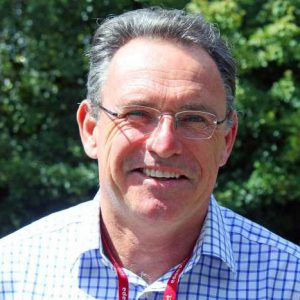Continue exploiting natural resources until they are gone, or regenerate them and re-establish human relationships with the natural world – it’s up to us
‘We are living at a point in time when human society’s influence on the environment, and the environmental impact of our individual lives, has never been as strong,’ says Mike Maunder of the Eden Project, ‘and when we have a choice between the continued mining of natural resources, or a regenerative approach that re-establishes them and the human relationships with them.’
Director of Life Sciences at the Eden Project in Cornwall, Mike will be discussing this choice at the Wellness and Biophilia Symposium at BRE Watford in June, in his presentation on Living in the Anthropocene: Developing a Regenerative Agenda.

Mike Maunder, Director of Life Sciences at the Eden Project, will be a keynote speaker at the Wellness and Biophilia Symposium at BRE in June.
The Human Epoch
The Anthropocene is the proposed new geological epoch (we have been in the Holocene since the last Ice Age) dating from the start of significant human impact on the Earth’s geology and ecosystems.
‘We used to think of our influence on the environment as being local or regional,’ says Mike. ‘But we are now directly influencing geological cycles and global climate, and will be able to see the impact of our species on the planet over geological time. The way materials – metals and plastics, etc – are deposited, and nutrients flow across the planet, for example, are driven by us.’
‘Human society is directly influencing the engines of the environment.’ Mike Maunder
A regenerative agenda
A regenerative agenda takes our response to this human impact beyond attempts to reduce the damage we’re doing, to a point where we start turning things around. ‘It’s no longer enough to minimise loss,’ says Mike, ‘we must maximise biological and societal benefits. We need buildings, for example, with net positive energy generation and water harvesting, and towns and villages that deliver net biodiversity gain – with a corresponding net gain in the richness of life and the health and wellbeing of the people living there.’
Mike believes that this is something that all of us as individuals can actively participate in, rather than waiting for politicians to take the lead. ‘Politics is a clumsy beast and we need to just get on with it as individuals, and on a project by project basis – as we do at the Eden Project where everything is dictated by a regenerative agenda.’
This is reflected in the development of the Eden Project itself, where a toxic industrial wasteland has been turned back into a working landscape with huge biomes housing extraordinary plant collections and set in beautiful gardens. It is now a major tourist destination, and a hub for business and for conservation and research. Eden also works with partners throughout the world on a variety of regenerative projects, from abandoned zinc mines in Thailand and brownfield developments in China, to the UK’s National Wildflower Centre.
The National Wildflower Centre, which became part the Eden Project in 2017, is rebuilding biodiverse landscapes – both urban and rural – all around the UK. ‘By bringing back the wildflowers we initiate a wonderful regenerative process that supports hosts of other species and brings delight to thousands of people,’ says Mike.
Biophilia
The National Wildflower Centre will be one of the projects reported on by Mike at the Wellness and Biophilia Symposium in June. The term biophilia (meaning love of nature) was coined in 1984 by Harvard professor Edward O. Wilson, who concluded that people have a biological need for physical, mental and social connections with the natural world.
A growing body of evidence that being in natural environments – or even viewing depictions of nature – can enhance wellbeing, has encouraged the use of biophilic design to bring people in the built environment back into contact with the natural world. This is not just about incorporating plants, though they are an important element, but also natural materials and textures, colour variations, views of nature, personalised workspaces, enhanced lighting, refuge spaces and much besides.
A research project at the Watford campus of building science centre, BRE, which aims to provide hard scientific evidence to underpin biophilic design, will be reported on at the Symposium in June. An entire floor of a typical office building – and its 40 occupants – is being intensively studied before and after a major refurbishment that will introduce a range of biophilic products and strategies.
Mike Maunder emphasises that biophilic design is not only concerned with the wellbeing of people. ‘Biophilia is a two-way relationship,’ he says. ‘While using nature and natural materials in our living and working environments to improve our health and wellbeing, we must also deliver the other side of the formula, which is using these environments to promote more biodiversity. It’s not just extracting benefit for us, but also us repaying the debt.’
With support from the BRE Trust, the Wellness and Biophilia Symposium – Using Nature-Inspired Design to Foster Workplace Wellness is being held on 6-7 June at BRE Watford. For more information visit the website here, email [email protected] or tel: 03333218811.
Source: Tom Harvey, Communications Consultant, BRE Trust
